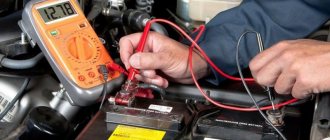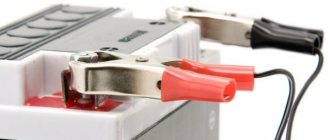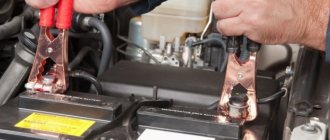When should you charge the battery? We list the cases
It is important to start charging the battery at the right time. If you charge it every week, after six months there will be nothing left of the lead plates, and the electrolyte will become cloudy. Periodic charging will not save the battery or extend its life. You need to charge the battery only at the moment when it is really necessary. If you do this too often, you will simply shorten the life of the device and speed up the time for replacement.
Here are some indicators that it’s time to charge the battery:
- indicator on the battery itself - some batteries have special indicators that allow you to determine the charge level in time and renew it if necessary;
- readings from the on-board computer - you should sometimes monitor the voltage in the network before starting the engine using various devices; low voltage indicates that the battery is no longer working well under load;
- changes in the nature of engine starting - if the engine starts starting with a stop during rotation, with a changed sound, too slowly, then it’s time for you to look at the health of the battery;
- more than 3-4 years have passed since the first installation of the battery in the car, at this stage it is necessary to check the performance of the device under load and recharge it to its optimal state;
- When measuring, the device shows low voltage, especially at the moment of load - you can measure these parameters even with a regular tester in order to understand the characteristics of the device’s condition.
Batteries last no longer than 5 years in normal mode. Usually after this period they begin to require constant maintenance. In order not to charge the battery every week, at this stage it is better to purchase a new battery. Usually, specialized stores have a stand for testing batteries under load. This makes it as simple and comfortable as possible to check the battery for the integrity of the plates and the normal state of the electrolyte.
Properly checking the battery before purchasing
Rule one: before buying a battery, you need to check it. How to do it? There is a simple sequence:
- Look at the date of manufacture. A car battery is not a battery. Even when it just sits on a shelf in a dry and warm warehouse, it gradually consumes the resource allocated by the manufacturer. Less than 6 months have passed since the date of manufacture - suitable, more than 6 months or even a year - you need to look further.
- Check the new battery with a multimeter and a load fork. Set the multimeter to DC voltage measurement mode and touch the battery terminals with the probes. The correct indicator is 12.7 V, a little less will do, for example, 12.5 V, but no more. The load plug should show at least 9 V.
- Installation on a car. This is the last step, but before installing the battery on the car, make sure that there is no current leakage in the on-board network. If there is none, then starting the engine on a new battery should be quick, with the nominal rotation of the starter.
With what current and for how long should I charge the battery?
To restore the charge, it is most convenient to use a special charger. However, not every device can cope with charging a large capacity battery. Unfortunately, the most affordable devices sold in stores are only capable of charging batteries in small cars. There are not enough of them for large containers. Buying an expensive charger is not always advisable. It is cheaper and easier to change the battery when problems arise in its operation.
Charging current characteristics:
- you need direct current, so you will need a converter if you do not have a standard charger;
- the voltage should not exceed 16.2 V, otherwise the lead plates in the device will lose their properties;
- The current strength is measured depending on the battery capacity, and this is one of the most important parameters;
- to charge in 10 hours, a current of 1/10 of the nominal capacity of the battery will be required, and for a 20-hour charge, 1/20 of the capacity will be sufficient.
Only when charging with direct current can you achieve full restoration of the battery charge. Otherwise, the battery will remain only 75-80% charged. In addition, alternating current is dangerous for lead plastic, which can begin to deteriorate if the charging conditions are violated in any way.
The rate of battery recharge depends on many factors. In particular, the battery capacity and the type of charger are taken into account. If the charging complex can produce a sufficiently high current, charging proceeds quickly. However, you cannot charge car batteries too quickly, otherwise they will simply fail. The optimal charging time is 8-10 hours or more.
At What Battery Charge Does the Car Won't Start ~ AUTOINTERLINE.RU
At what charge is the car
does not start
Archie: Hello everyone! Tell me what the normal voltage of the battery is when the car is in security mode. I saw that if Voltam drops below 12V (I look at the alarm), Battery low starts flashing from time to time on the standard radio. What remains for our client to do that is below 12V. is this a critical charge ? The car only costs a little more than a day, now the battery is 11.8V. What to do: change the battery? Try charging from the mains? Another question: at what charge will I no longer start? throw away the key fob from the signaling device and never look there, it will continue to indicate incorrectly and go to a normal electrician to check the battery (level, density, charging, leakage current) Why do the electrolyte density of a charged battery in our band to be 1.26, in Africa. 1. 17?
The reason is ordinary to the point of banality, of course there are two factors: 1. The denser the electrolyte, the better the process of corrosion of the battery plates. At a density of 1.30 and above, it is generally very active. 4.5. The less dense the electrolyte, the lower its freezing point.
Roughly speaking, it’s time to choose the density of the electrolyte so that its freezing temperature during practically working discharge (this is approximately minus 0.16 from a 100% charged density) is higher than low winter temperatures in the given region. On the other hand, it (the initial density) does not have to be very high, otherwise the battery will not be enough for one winter. Hence the compromise of 1.26 charged and 1.10 completely discharged. Sometimes, with winter temperatures of .55, this is unrealistic. in general, in regions where it happens in winter.55 in any case, cars try not to cool down to such temperatures.
The starter does not turn. Is it a battery?
In the main part of the troubles, when not
the starter turns, it’s
not the battery that
, as users probably think.
6 ways to start your car if the battery is dead
How to start a car
what if
the battery
? Are you sure you know how to light a cigarette correctly? Life time.
The density of the electrolyte itself does not affect the operation of the battery (within reasonable limits). only the freezing temperature
and plate corrosion rate. Moreover, in a battery that has lost its effective capacity, the density of the electrolyte may be normal, and it may also be normal in a shortened battery. I don’t remember electrochemistry well, but the essence of the discharge process is the transformation of sponge lead contained in the plate into lead sulfate (PbSO4 if I’m not mistaken with the valency of lead), in which sulfuric acid is taken from the electrolyte, and the reduction of PbSO4 to sponge lead during charging.
Therefore, the process of sulfation (and the notorious sulfation is the deposition of the same PbSO4 on the surface of the plates with a decrease in their effective area) is accompanied by a decrease in the density of the electrolyte, but the degradation of the plates (their corrosion, shedding, etc.) may not be accompanied by this.
Also, a shortened can may have a normal electrolyte density
(I suppose I don’t remember the last one.) Hence, assigning an absolute value to the density of the electrolyte is erroneous. The main sign of battery health is its normal behavior on the load plug, and indirect signs of its irreversible degradation are rapid self-discharge, charging too quickly, and a strong drop in the voltage of a fully charged battery on the load plug.
Post Views: 8
How do you know when to disconnect the battery from charging?
If you are using a charger, the easiest way to know when it is time to remove the battery from charging is to look at the indicators. Of course, this does not always accurately show the state of charge of the battery, but it allows you to navigate the state of the battery. In cheap chargers, indicators often do not provide any information at all; they simply light up gradually one after another, and their work is not related to charging the battery.
If there are no indicators on your charger, you can use one of the following methods:
- Multimeter. Using a simple tester, you can measure the voltage at the battery poles and get an understanding of what stage of charging it is at. Without load, a charged battery produces 14-15 V.
- Charging time. If you charge the battery with a current equal to 1/10 of the battery's rated capacity, then after 10 hours there will be no point in continuing this activity. If the battery is working properly, it will take its charge during this time. If the charge is not restored, the battery can be safely replaced.
- Heat. During the basic charge recovery process, the battery does not heat up. The case remains cool, despite the fact that certain processes take place inside. If heating occurs, the battery has taken all it can take.
It is best to rely on measurements with a multimeter. This device will show the amount of direct current and allow you to understand at what point the battery produces enough voltage to continue to be successfully used in the car. Determining the charge level by the temperature of the case is very inaccurate and can hardly be used as the only factor that will tell you when charging is complete.
What you need to know when buying a new battery
Additional preparation before purchasing will not be superfluous. The battery is a critical part, so before putting it in the car, it is checked.
Battery inspection and testing
How to check new batteries:
- look when it was made. A battery is not an ordinary battery, therefore, when it is stored in a warehouse, even in dry and warm conditions, it consumes its working life. It is better to choose a part that has been manufactured for no more than six months;
- take into account the dimensions so that it “fits” into the seat. A difference of 2 - 3 cm can be significant, so when going for a new battery, it is worth finding out the geometric parameters of the old one;
- look at how the terminals are located. “Plus” and “minus” can be located on different sides of the battery. And, if the supply cable is short, then connection may be difficult.
- Using a multimeter and a load fork. Taking a multimeter, it is switched to DC voltage measurement mode. The probes of the device are connected to the battery terminals. The norm is considered to be 12.7 V (it can be less, for example, 12.5 V). If more, it’s better to take a closer look at another detail. The load plug should show at least 9 V.
- They put it on the car. Before installing the battery, check whether there is a current leak in the on-board electrical network of the car. If everything is in order, the engine will start quickly, at the rated starter speed.
Battery testing
When buying a battery, there is a chance that it has been in storage for a long time. The permissible shelf life for this part is one year. But, even if six months have passed since the date of manufacture, it is better to refuse the purchase.
To find out the approximate battery charge level, use a voltmeter. A fully charged battery has a voltage of 12.6 - 12.9 V. If it shows less than 12.5, it means it requires recharging. Full charging is needed in advanced cases when the device produces a voltage of 11.9 V.
You can also measure the level and density of the electrolyte contained in the housing. This is done with a device - a hydrometer.
Is it possible to charge a completely discharged battery?
Sometimes car owners find themselves in an unpleasant situation when the generator fails, and they have to drive for a certain time, consuming electricity exclusively from the battery. With such a load, the battery is deeply discharged and stops functioning at a certain point. Also, complete discharge is possible if you tow a car for a long time with the hazard warning lights on. Another chance to deeply discharge the battery is a long period of idle time of the car in the garage, even without consumers turned on. Leaving the radio overnight or the headlights on for several hours will also quickly drain the battery in your car.
In this case, the following processes occur in the battery:
- At first, the lead plates simply release the charge through a chemical reaction, this is the normal operating mode of a car battery;
- then, with each lost ampere-hour, the chemical composition of the electrolyte in the battery banks will begin to change, the volume of acid will increase;
- along with an increase in the volume of acid, the effect on the lead plates increases, they begin to become covered with deposits in the form of sulfate crystals;
- the electrodes become clogged, which reduces their ability to discharge a charge, and the aggressive electrolyte gradually “kills” the plates;
- the longer the attempt to extract the last ampere-hours from a dying battery lasts, the less chance there is of bringing it back to life;
- the accumulated deposit of sulfate crystals will no longer allow the plates to fully accept the charge when trying to charge such a battery.
As a rule, after a deep discharge, batteries cannot be restored normally. They can take a certain part of the charge, but they will not return their former efficiency. Therefore, it is not uncommon for car owners to find themselves in unpleasant situations due to attempts to restore and charge the battery after a deep discharge. You should try to evaluate the quality of the battery and the possibility of its restoration before installing it again on the car and hoping for long-term service.
Simple rules for charging batteries
To avoid damaging the battery in your car, you need to follow simple rules. Based on everything said above, we have prepared recommendations that will allow you to most effectively restore a slightly dead battery and bring it back to life. But first, make sure that a deep discharge has not occurred. This will help you prevent unpleasant situations on the road.
The rules are as follows:
- First, make sure that the battery has not been deeply discharged; it can still be restored by charging. Also consider the age of the battery. If it is more than 4-6 years old, restoration may not bring any results.
- If possible, use high-quality and powerful chargers that can be adjusted to a specific battery capacity. This will allow you to professionally and safely restore the battery charge.
- Do not exceed 10% of the rated capacity. For example, a battery with a capacity of 60 Ah can be charged with a direct current of 6A. In this case, the battery will restore its charge in 10 hours.
- Be sure to check the battery in your car before each winter season. This will allow you to go through a dangerous season for your power source much more confidently without problems or troubles.
- Measure the density of the electrolyte and check the fluid level in the battery banks. Otherwise, charging may be the last action with your battery, after which it can be safely sent for recycling.
You should not buy too cheap batteries from unverified companies. Otherwise, you will face rapid equipment failure. But it makes no sense to purchase the most expensive batteries. A sudden generator failure or other circumstances can damage the battery. And here it will not matter how high-quality the battery you bought.
We also suggest watching a video with instructions on charging a car battery:
Operating a new car battery
To avoid having to go to the auto shop again in a year, you need to know how to prepare the battery for use and use it in the future. For those who have a vague idea of what to do with a new battery, we have prepared two instructions.
First of all, you need to choose the right battery - it must meet the parameters specified by the car manufacturer. Otherwise, our recommendations will be useless.
Correct battery charging.
Preparing the battery for operation consists of the following steps:
- Remove the packaging and wipe the case with a clean rag.
- If the battery is serviceable, remove the plugs and measure the density of the electrolyte (should be 1.27-1.28 kg/cm 3 ).
- Charge the battery.
- Clean the contacts with sandpaper and wipe with a clean rag.
- Carefully, avoiding sparks, connect the terminals.
If you have an old car that does not have on-board electronic devices (radio, alarm, computer, etc.), use instruments to check for possible current leakage. Normally, the value should not exceed 15 mA.
Battery operating rules
Follow our recommendations to extend battery life and prevent interruptions in the operation of on-board electronic devices.
- Immediately after the first trip with a new battery, check the voltage at idle and with the energy consumers turned off (the norm is at least 13.5 V).
- Periodically inspect the housing for mechanical damage that may occur due to improper use or exposure to severe frosts.
- Once a month, remove accumulated dirt from the surface of the case.
- Be careful when lighting up another car. There is a risk of electrical wiring burning out when the ignition is turned on.
- Regularly check the electrical equipment of the car: even a minor malfunction of the generator or relay can negatively affect the performance of the battery.
- Do not allow the battery to become critically discharged (less than 30% of capacity) - when the internal combustion engine is not running, do not turn on the headlights or radio for a long time.
- Check the quality of the battery fastening to avoid mechanical damage to the case.
If you are not confident in your skills, contact a specialist once every six months to inspect the battery and possible technical work. It is better to entrust the matter to someone who knows than to try to deal with the problem yourself and ruin the battery.
As you can see, operating the new battery is not particularly difficult. The main thing is to periodically look under the hood and check the condition of the battery.
Rules for charging a new battery
If you become the owner of a classic lead-acid battery, then take precautions when installing or recharging. Remember that there is acid inside the battery, which can pose a threat not only to health, but also to life.
Acid burns are very painful and leave scars for life, therefore, when servicing a new battery, it is recommended to work with special gloves that prevent the hazardous substance from coming into contact with the skin.
This advice is especially relevant for those craftsmen who carry out battery maintenance or repair at home.
Let's sum it up
Modern car batteries can fail quite quickly. Especially if you purchased a budget option or a model from the mid-price range. Manufacturers do not care too much about durability, so 4 years for such batteries becomes a heroic service life. If your inexpensive battery lasts so long and then starts to show problems, it is much easier to replace it with another one than to try to charge and restore it. However, charging for several months can extend the life of an old device.
It is worth charging the battery if the battery is relatively new, but it has been exposed to unfavorable operating conditions and has lost part of its charge. And if in the summer even 20% of the remaining battery capacity is usually enough to start the car, then in the cold season you will have to use much more battery capacity and power to start. Therefore, before winter, it is better to once again check the performance of the battery in order to eliminate all shortcomings and problems. Be sure to follow simple rules for charging your battery to get the necessary performance parameters.
Preparation for use
Many people believe that a new battery needs to be “trained” by charging and discharging it.
For newly purchased blocks, this procedure is not required; moreover, it can be harmful.
There is also a situation when they take the battery, put it in the car, check it and, if everything works, turn off the engine, and leave the car idle for a week.
New batteries that have not been used are dry-charged, designed for the driver to drive immediately.
Do I need to charge a new car battery?
According to experts, even a new battery requires recharging. The reason lies in the fact that the battery, before falling into the hands of the buyer, is stored in a warehouse, at which time its capacity naturally decreases.
Therefore, first of all, they look at the manufacturing date of the battery and, based on this information, decide whether to charge it or not.
Thanks to modern technologies, current batteries have virtually no self-discharge. But for this to really “work”, it is necessary to adhere to the storage conditions. What does self-discharge depend on:
- from the ambient temperature (normal values are from +5 to +20 degrees Celsius);
- air humidity parameter;
- dirty storage area.
As a result, even a new battery, after two months of storage in unsuitable conditions, can lose 20–40% of its capacity. Therefore, it is better to play it safe and check whether the car battery needs recharging.
How to charge the battery
There are practically no differences between charging a new and old battery. The difference is how long it takes to charge a serviced or unattended power supply. The method of supplying voltage will depend on this.
New serviced batteries are charged with alternating voltage. The advantage of this technique is that the electrolyte does not “boil” during charging, which has a beneficial effect on the further operation of the battery. Step-by-step instruction:
- They take the battery out of the car and check the temperature of the electrolyte, which should not be higher than +35 degrees.
- The rheostat of the charger is set so that the voltage across the terminals is no more than 10% of the total capacity of the power source.
- If everything is correct, bubbles will begin to appear in the electrolyte. At this stage, the voltage at the contacts is measured.
- If it shows 14.4 V, the supplied current is halved.
- Charging is continued until the voltage rises to 16 V and remains the same for three hours.
If a new but maintenance-free battery is available, it is charged with constant voltage. The current strength does not change. The advantage of the method is that the heating of the electrolyte is reduced, and the full capacity of the battery is achieved after about 5 hours.











